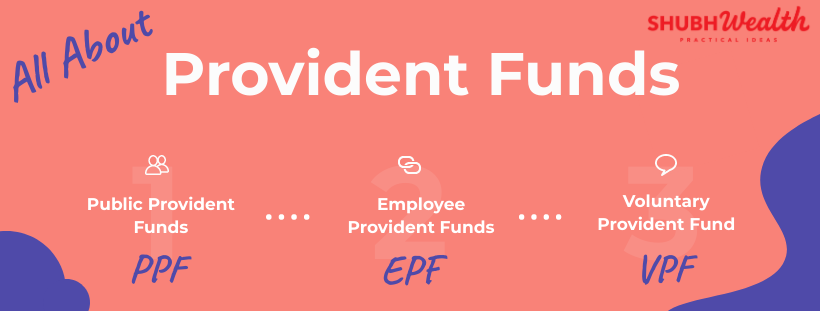Voluntary Provident Fund (VPF) is one scheme that has benefits of better returns with low risk. As we all look for investment opportunities that can give good returns with low-risk VPF it’s the bill perfectly.
The scheme is open to salaried employees only. It is secure as backed by the government of India, has a good return in Debt category, and tax-efficient (gains are tax-free).
Voluntary Provident Fund (VPF)
Voluntary Provident Fund (VPF) can be considered for investment purposes in the debt category by salaried employees.
The reason to choose VPF against traditional debt investment like Bank Fixed Deposits (FD), Debt Mutual Funds, Bonds and Debentures are Following …
- Secure investment – Backed by Government of INDIA
- High-Interest Rate – Better than Bank Fixed Deposits
- Tax-Free Return – The gains are tax-free
- No limitation on investment – You can invest up to 100% of your (basic + DA)
These features make VPF an excellent opportunity for investment. The current interest rate (FY 2019-20) is 8.65%, which is tax-free. Most of the other tax investment is taxable on maturity like BANK FD or DEBT MUTUAL FUND or Bonds and debentures.
The comparable pre-tax return under Voluntary Provident fund is more than 12 % for the investor under 30% tax bracket.

Highlights
- Governed by Employees’ Provident Funds & Miscellaneous Provisions Act, 1952
- The plan is open for only SALARIED EMPLOYEES.
- Contribution can be a maximum of 100% of Your BASIC+DA.
- VPF account can be opened the same way as EPF, by contacting company HR team
- TAX BENEFITS under VPF is EEE (EXEMPT, EXEMPT, EXEMPT), i.e., your investment, accumulation and withdrawal are tax exempt
- Investment under VPF considered for tax benefit under section 80C within the overall limit of 1.50 lakh; the interest accumulated is non-taxable, and withdrawal from VPF is tax-free.
- The rate of Interest is decided every year by Employee Provident Fund Organisation (EPFO) and is same as Employee Provident Fund (EPF)
- Companies registered under EPFO are allowed to open EPF account and VPF account
- Withdrawal before five years of service is taxable and can place through your company HR or EPFO website using Universal Account Number (UAN) number.
- The UAN number is the same for EPF and VPF, as provided by EPFO.
- The VPF has the same lock-in period as the EPF — on retirement or within two months of unemployment
Employees Provident Fund (EPF)
- Governed by Employees’ Provident Funds & Miscellaneous Provisions Act, 1952
- The Board administers a contributory provident fund, pension scheme and an insurance scheme for the workforce engaged in the organized sector in India
- Ministry of Labour and Employment, Government of India, administer Employees’ PF Organization (EPFO).
- Companies having more than 20 employees by regulation has to register with EPFO.
- While contributing towards EPF is necessary for those earning basic wages of up to Rs 15,000. Those earning basic wages more than 15000 per month, EPF contribution is not compulsory.
- The employer can choose to limit its contribution towards EPF to 12 percent of Rs 15,000 (Rs 1,800) under Section 26A of EPF act for those employees earning more than Rs 15,000 per month as basic wages.
- The Employees’ Provident Fund is a fund where both the employer as well as the employee contributes a part of the salary
- The employee post-resignation is free to withdraw his/her 75% of the EPF fund after one month of the date of having quit the job and remaining 25% after two months of unemployment
- EPFO allows a unique 12-digit permanent number known as Universal Account Number (UAN) to the member who joins the organization registered under EPFO.
- TAX BENEFITS under VPF is EEE (EXEMPT, EXEMPT, EXEMPT), i.e., your investment, accumulation, and withdrawal are tax exempt
Schemes covered under EPFO board
- The Board operates three schemes
- The Employees’ Provident Funds Scheme 1952 (EPF)
- The invested amount along with interest investor or nominees get post-retirement, resignation or death
- For house construction, higher education, marriage, and illness partially withdrawal is allowed
- The Employees’ Pension Scheme 1995 (EPS)
- Monthly benefits for superannuation/ retirement, disability, survivor, widow (er), children
- Amount of pension based on average salary during the preceding 12 months from the date of exit and total years of employment
- The Employees’ Deposit Linked Insurance Scheme 1976 (EDLI)
- The scheme provides benefits to the nominee or legal heir post-death of employee
- benefit amount to be 20 times of the wages or based on the deposit in the Provident Fund, whichever is less
- increase in the wages ceiling to 15000/- from 01.09.2014, the maximum benefit amount has become 3 lakh, and an additional 20% of the benefit amount calculated is also paid
- The Employees’ Provident Funds Scheme 1952 (EPF)
Public Provident Fund (PPF)
- In 1968, The National Savings Institute bought a Public Provident Fund(PPF) scheme.
- PPF account is open for all INDIAN citizens, No HUFs
- In a Financial year subscriber can deposit from Rs 500/- (minimum) to 1,50,000/- (maximum)
- Deposit in PPF account qualified for deduction in income under Sec- 80 C of Income Tax Act
- Interest earned in the PPF account is exempted from Income Tax under Sec-10(15 of Income-tax Act).
- The Investment matures after 15 complete financial years barring FY in which investment is made.
- From 7th FY withdrawal is permissible once every year
- Loan Facility is available from 3rd till 6th FY
- The account can be extended for any number of blocks of 5 years with further deposits
- After maturity, the account can be kept indefinitely at the prevailing interest rate
- There is no entry age for the opening of account
- The account can be opened online or offline at most Public or Private sector banks and Post offices
- The interest calculated is yearly compounding in nature, Interest calculated monthly but credited yearly
- Rs 100 is charged as account opening charges.
- In a financial year, one can deposit 12 times and a maximum twice in a month.
- The amount deposited from 1st -5th of any months are considered for interest calculation of current month
- For online account opening, Aadhar has to seed in the bank account, and mobile number has to be same in the bank account and Aadhaar
- Dormant PPF account can be activated by paying a penalty of Rs 50 for each year of dormancy
Conclusion
All three types of provident funds have their own merits and cater to a different segment of investors.
While PPF is a well-known investment vehicle popular with business class and unorganized sector, the ease of investment and sovereign backing has made the product a household investment vehicle.
EPF is more of a compulsion for all salaried employees in the organized sector. Your investment allows many tax benefits like while investing (under SEC 80C) and on accumulation and maturities are tax-free.
This article is to bring to your notice on the third type of provident fund, which is the Voluntary Provident Fund (VPF). VPF is not as popular among the salaried class as they are not mandatory by regulation.
This investment vehicle provides you high return compared to a traditional investment like bank fixed deposits, debt mutual funds etc. Taxation on Debt mutual funds are lower than bank fixed deposit due to INDEXATION BENEFITs.
I would recommend you to add this product in your investment basket owing to features like safety(government-backed), return(high debt return)and taxation(No tax on maturity).
ShubhWealth





One of the best blogs that i have come across which has every minute details related to the concerned topic well explained in a layman’s language .
Thank you 👍
Rakshitha, Thanks for your appreciation be in touch.
New Information, good to get something new. keep good work going.
What a post! That is so chock full of useful information I can’t wait to dig deep and get started
utilizing the resources you’ve given me.
Best regards,
Dinesen Duke
This paragraph offers clear idea for the new viewers of blogging, that
really how to do blogging.
Pingback: Best Post office (Tax Saving) schemes under Sec 80C
Very very good job and thanks for sharing such a good blog.
Best regards,
Boswell Dencker
This website was… how do you say it? Relevant!!
Finally I’ve found something that helped me. Kudos!
Thank you for taking the time to write and post this material.
Best regards,
Harrell Hessellund
Very nice article. I certainly love this site. Stick with it!
This article is a source of inspiration for me, it helps me a lot
in sleep problems. I also used this Rain Sounds https://youtu.be/uSxflHAxweE to fall asleep easily.
Thanks, keep it up!
I am regular visitor, how are you everybody?
This article posted at this web page is actually pleasant.
Thanks a ton. you can also join my channel here.
https://www.youtube.com/channel/UCnELNPAjezGxNE-4QvPd9TQ
Pretty! This was an incredibly wonderful post. Thank you for supplying this information.
Sure..That would be great.
Nice blog here! Also your site loads up fast! What host are you using?
Can I get your affiliate link to your host? I wish my website loaded up as fast as yours
lol
Heya i’m for the first time here. I found this board and I to find It really useful &
it helped me out a lot. I am hoping to give something again and aid others like you helped me.